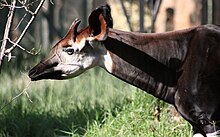Ossicone


Ossicones are columnar or conical skin-covered bone structures on the heads of giraffes, male okapi, and some of their extinct relatives. Ossicones are distinguished from the superficially similar structures of horns and antlers by their unique development and a permanent covering of skin and fur.
Structure[]
Giraffe ossicones consist of a highly vascularized and innervated bone core covered with vascularized and innervated skin.[1] The base of an ossicone is attached to the skull with vascularized innervated connective tissue.[1] Ossicones are formed at late gestation, but in early development they are not bony and not fused to the skull yet. Ossicones usually fuse to the skull at sexual maturity.[1][2]
All male and female giraffes have a pair of parietal ossicones on the parietal bones of the skull.[3] Males also usually have a single median ossicone on the frontal bone that is larger in northern animals and smaller in southern giraffes.[3] Giraffes can also have small additional paired occipital ossicones on the occipital bones, paired orbital ossicones associated with eyes, and azygous ossicones.[3]
In giraffes, male and female ossicones vary in structure and purpose (a manifestation of sexual dimorphism). Males typically have thicker ossicones that become bald on top due to frequent necking.[4] In okapi, the male's ossicones are smaller in proportion to the head, and taper towards their tips, forming a sharper point than the comparatively blunt giraffe ossicone. Whereas female giraffes have reduced ossicones, female okapi lack ossicones entirely.
The morphology of ossicones in the extinct relatives of giraffes and okapi varies widely. Some species had two pairs of ossicones rather than one (e.g. Giraffokeryx), some had rugged textures (e.g. Shansitherium), and some had large, flattened ossicones (e.g. male Prolibytherium).
Function[]
Similar to species that possess horns or antlers, male giraffes use their ossicones as a weapon during combat where they use their heads as clubs with the ossicones concentrating the force of impact onto a small area. Ossicones also add weight to the animal's head, allowing it to deliver heavier blows.[4] The nerve bundles and large blood supply in the ossicones led some researchers to speculate that the structures may also play a role in thermoregulation.[1]
Examples[]

Ossicones are only found in some members of the superfamily Giraffoidea, which includes the family Giraffidae (to which giraffes, okapi, and extinct relatives belong) and the entirely extinct family Climacoceratidae.[5] It has been argued that the so-called ossicones known from fossils are actually horns; however, later research has revealed these structures to be consistent with the ossicones of giraffes and okapi.[6] The following is a list of some ossicone-bearing genera:
- Giraffidae
- †Bramatherium (2 pairs)
- †Decennatherium (1 pair)
- Giraffa (giraffes; 1 pair)
- †Giraffokeryx (2 pairs)
- †Honanotherium (1 pair)
- †Injanatherium (2 pairs) – Angled horizontally relative to head
- †Mitilanotherium (1 pair)
- Okapia (okapi; 1–0 pairs) – Females lack ossicones
- †Palaeotragus (1–0 pairs) – Some species lacked ossicones
- †Samotherium (1 pair)
- †Shansitherium (1 pair)
- †Sivatherium (2 pairs)
- Climacoceratidae
- †Climacoceras (1 pair)
- †Prolibytherium (1 pair) – Male ossicones plate-like; females more typical
References[]
- ^ Jump up to: a b c d Ganey, Tim; Ogden, John; Olsen, John (1990). "Development of the giraffe horn and its blood supply". The Anatomical Record. 227 (4): 497–507. doi:10.1002/ar.1092270413. ISSN 1097-0185. PMID 2393101.
- ^ Nasoori, A (2020). "Formation, structure, and function of extra-skeletal bones in mammals" (PDF). Biological Reviews. 95 (4): 986–1019. doi:10.1111/brv.12597. PMID 32338826.
- ^ Jump up to: a b c Spinage, C. A. (1968). "Horns and Other Bony Structures of the Skull of the Giraffe, and Their Functional Significance". African Journal of Ecology. 6 (1): 53–61. doi:10.1111/j.1365-2028.1968.tb00900.x. ISSN 1365-2028.
- ^ Jump up to: a b Geist, Valerius (1966). "The Evolution of Horn-Like Organs". Behaviour. 27 (1): 175–214. doi:10.1163/156853966x00155.
- ^ Hadar Picture Gallery. An ossicone of the extinct, giant, short-necked giraffe. University of Washington.
- ^ Solounias, N (1988). "Prevalence of Ossicones in Giraffidae (Artiodactyla, Mammalia)". Journal of Mammalogy. 69 (4): 845–8. doi:10.2307/1381645. JSTOR 1381645.
Further reading[]
- Hou, Sukuan; Danowitz, Melinda; Sammis, John; Solounias, Nikos (2014). "Dead ossicones, and other characters describing Palaeotraginae (Giraffidae; Mammalia) based on new material from Gansu, Central China". Zitteliana. 32: 91–8.
- Solounias, N; Moelleken, S. M. C (1991). "Evidence for the Presence of Ossicones in Giraffokeryx punjabiensis (Giraffidae, Mammalia)". Journal of Mammalogy. 72 (1): 215–7. doi:10.2307/1382004. JSTOR 1382004.
- Churcher, Charles S (1990). "Cranial Appendages of Giraffoidea". Horns, Pronghorns, and Antlers. pp. 180–94. doi:10.1007/978-1-4613-8966-8_5. ISBN 978-1-4613-8968-2.
- Davis, E. B; Brakora, K. A; Lee, A. H (2011). "Evolution of ruminant headgear: A review". Proceedings of the Royal Society B: Biological Sciences. 278 (1720): 2857–65. doi:10.1098/rspb.2011.0938. JSTOR 41315010. PMC 3151718. PMID 21733893. Lay summary – ScienceDaily (July 10, 2010).
- Danowitz, Melinda; Barry, John C; Solounias, Nikos (2017). "The earliest ossicone and post-cranial record of Giraffa". PLOS ONE. 12 (9): e0185139. Bibcode:2017PLoSO..1285139D. doi:10.1371/journal.pone.0185139. PMC 5605118. PMID 28926638.
- Ríos, María; Sánchez, Israel M; Morales, Jorge (2017). "A new giraffid (Mammalia, Ruminantia, Pecora) from the late Miocene of Spain, and the evolution of the sivathere-samothere lineage". PLOS ONE. 12 (11): e0185378. Bibcode:2017PLoSO..1285378R. doi:10.1371/journal.pone.0185378. PMC 5665556. PMID 29091914.
- Mammal anatomy